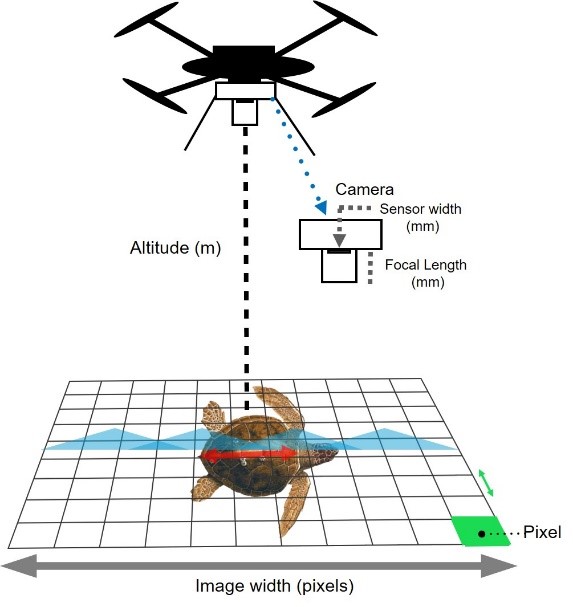Drones not only take great photographs—they can also be used to take measurements. In our case, we use them to measure the size of sea turtles seen in the wild.
Photogrammetry is the process of getting reliable measurements from photographs. This technique has been used for more than 100 years, primarily to create maps from aerial photos. With advanced drone technology, biologists are using photogrammetry to measure sea turtle species like leatherbacks, loggerheads, and Kemp’s ridleys.
Collecting size information using photogrammetry helps us understand what age groups of different sea turtle species are using which areas, and when. For example, scientists from NOAA’s Southeast Fisheries Science Center recently used this method to measure juvenile green sea turtles in coastal Louisiana. At another site in North Carolina, we saw and measured adult and juvenile loggerhead sea turtles. This might suggest that different species of turtles occur within different regions. Collecting information on size and habitat use informs conservation management strategies and helps assess progress toward recovery. Another benefit: measurements can be made without having to capture and handle the turtles. This means more animals can be measured in a day and the turtles don’t even know we’re there.
How Photogrammetry Works
Photogrammetry uses:
- Basic features of the drone’s camera (focal length and sensor width)
- Height or altitude the drone was flying when the picture was taken
- Image width of the picture in pixels
By combining this information, we can determine the ground sampling distance which is how much actual area is represented in each photo pixel. Special software is then used to measure the turtles’ length in pixels and multiply it by the ground sampling distance. It then converts the measurement to an estimate of the live turtle’s length. This allows us to estimate how big the turtle is without ever touching it. To ensure we get the best estimate possible, we assign two independent scientists to measure the turtles in the photographs.
Overcoming Challenges
Water clarity plays a big role in how easy it is to see the turtles below the surface. The clearer the water, the further below the surface we can see them. If the water is murky, we can only see the turtles within a few feet—or even inches—of the surface. A team of scientists from the Southeast Fisheries Science Center and the Southwest Fisheries Science Center are using photogrammetry to measure green turtles in both the murky waters of San Diego Bay and the clearer waters off the coast of Florida.
To test the accuracy of this method, we temporarily placed toy sea turtles with known lengths in the water. We measured them from different altitudes using these photogrammetry techniques. Even when capturing images from 131 feet above the water, we were able to estimate the length of the smallest plastic turtle to within 0.4 inches of its actual size (9.6 inches).
Looking from above, an object under water appears larger than it does in air due to light’s refractive index. That means we get the most accurate measurements when the turtles come up to breathe and their shell (or carapace) breaks the surface. The accuracy of a size measurement can also be affected by the angle of the turtle relative to the surface. We are continuing to conduct experiments with our turtle replicas to get a better understanding of these factors and to maximize the accuracy of our measurements.
Research to Support Sea Turtle Protection
Six species of sea turtles are found in U.S. waters, all of which are listed and protected under the Endangered Species Act. We conduct research to better understand the population status, spatial ecology, demography, and human threats to sea turtles. This helps to provide timely scientific data and advice for protecting sea turtle species in the Southeast region.






